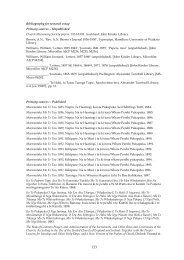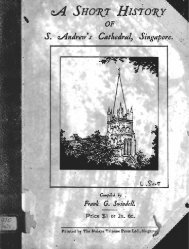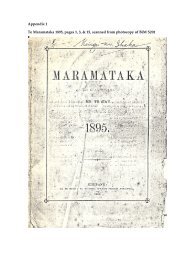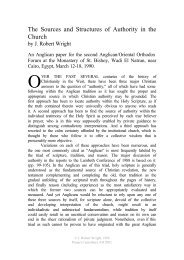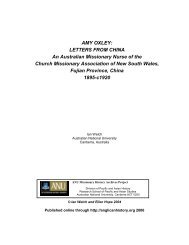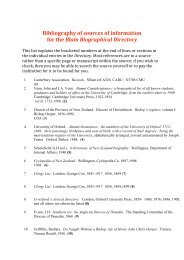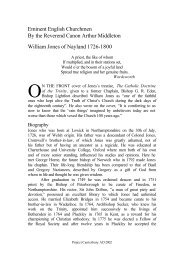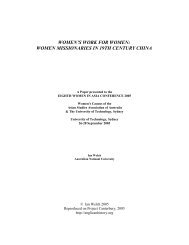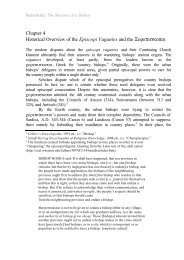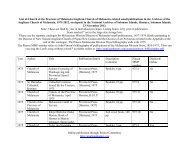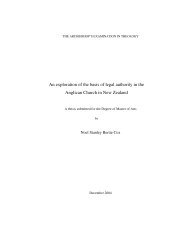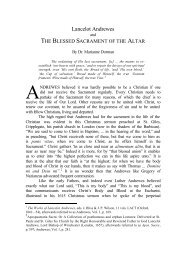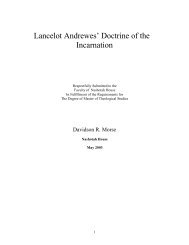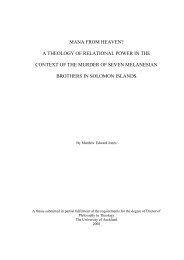The Influence of John Mason Neale and the - Project Canterbury
The Influence of John Mason Neale and the - Project Canterbury
The Influence of John Mason Neale and the - Project Canterbury
You also want an ePaper? Increase the reach of your titles
YUMPU automatically turns print PDFs into web optimized ePapers that Google loves.
<strong>The</strong> <strong>Influence</strong> <strong>of</strong> J.M. <strong>Neale</strong> <strong>and</strong> <strong>the</strong> <strong>The</strong>ology <strong>of</strong> Symbolism, by S.D. de Hart<br />
by <strong>Neale</strong> employs an a priori method <strong>of</strong> establishing <strong>the</strong> early Church as a reliable guide<br />
in <strong>the</strong> use <strong>of</strong> symbolism. <strong>Neale</strong> asserts:<br />
Indeed, almost every great doctrine had been symbolized at a very early<br />
period <strong>of</strong> Christianity. <strong>The</strong> resurrection was set forth in <strong>the</strong> Phoenix, rising<br />
immortal from its ashes: <strong>the</strong> meritorious Passion <strong>of</strong> our Saviour, by <strong>the</strong><br />
Pelican, feeding its young with its own blood: <strong>the</strong> Sacrament <strong>of</strong> <strong>the</strong> Holy<br />
Eucharist, by grapes <strong>and</strong> wheat ears, or again by <strong>the</strong> blood flowing from <strong>the</strong><br />
heart <strong>and</strong> feet <strong>of</strong> <strong>the</strong> Wounded Lamb into a chalice beneath. 16<br />
It was not only <strong>the</strong> early Church that taught symbolism; <strong>the</strong> earliest heretics also<br />
establish <strong>the</strong> antiquity <strong>of</strong> Christian symbolism:<br />
That fearful heresy, Gnosticism, which arose from an over-symbolizing,<br />
shews, never<strong>the</strong>less, how deeply <strong>the</strong> principle, with due limits, belonged to <strong>the</strong><br />
Church. 17<br />
Thus, <strong>Neale</strong> becomes <strong>the</strong> first to espouse a Scriptural apologetic for <strong>the</strong> use <strong>of</strong><br />
symbols in <strong>the</strong> nineteenth-century ritual controversy:<br />
Again, types <strong>and</strong> emblems without number were seen in <strong>the</strong> language <strong>of</strong> <strong>the</strong><br />
Psalmist, occurring so continuously in <strong>the</strong> Services <strong>of</strong> <strong>the</strong> Church. 'His<br />
faithfulness shall be thy buckler' gives rise to a fine allegory <strong>of</strong> S. Bernard's<br />
drawn from <strong>the</strong> triangular shape <strong>of</strong> <strong>the</strong> buckler used at <strong>the</strong> time when that<br />
Fa<strong>the</strong>r wrote; even as we shall see it in <strong>the</strong> effigies <strong>of</strong> early knights. It protects<br />
<strong>the</strong> upper body completely: <strong>the</strong> feet are less completely shielded. And so,<br />
remarks <strong>the</strong> Saint, does God's providence guard His people from spiritual<br />
dangers, imaged by those weapons which attack <strong>the</strong> upper, or more vital par<br />
<strong>of</strong> <strong>the</strong> body: but from temporal adversities He hath nei<strong>the</strong>r promised, nor will<br />
give so complete protection. 18<br />
In addition to <strong>the</strong> a priori argument, <strong>Neale</strong> makes an argument from analogy. He<br />
describes how God revealed Himself through <strong>the</strong> Divinely ordained Old Testament ritual,<br />
such as <strong>the</strong> tabernacle, <strong>the</strong> temple rites, <strong>the</strong> sacrificial observances, <strong>and</strong> <strong>the</strong> Passover. <strong>The</strong><br />
Old Testament model was viewed as exemplary for worship at all times. <strong>Neale</strong> would<br />
argue that it is improbable that <strong>the</strong> same eternal God who comm<strong>and</strong>ed ritual observances<br />
by <strong>the</strong> Jews would suddenly find it sinful to employ physical objects to convey spiritual<br />
truth <strong>and</strong> grace. A divine imperative given to <strong>the</strong> Church <strong>of</strong> old establishes a timeless <strong>and</strong><br />
eternal principle that could be followed by Anglicans in <strong>the</strong> nineteenth century.<br />
Now Catholicity, which teaches men constantly to live above <strong>the</strong>ir senses, to<br />
mortify <strong>the</strong>ir passions, <strong>and</strong> to deny <strong>the</strong>mselves...must constantly lead me by<br />
<strong>the</strong> seen to look on <strong>the</strong> unseen...But now, <strong>the</strong> Church, not content with<br />
15 J. M. <strong>Neale</strong>, Dur<strong>and</strong>us, p. xxxvi.<br />
16 J.M. <strong>Neale</strong>, Dur<strong>and</strong>us, p. xxxvii.<br />
17 J.M. <strong>Neale</strong>, Dur<strong>and</strong>us, p. xxxix.<br />
18 J.M. <strong>Neale</strong>, Dur<strong>and</strong>us, p. xliv.<br />
[4]



